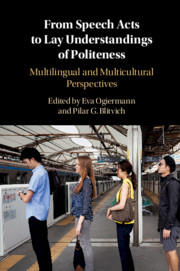Book contents
- From Speech Acts to Lay Understandings of Politeness
- From Speech Acts to Lay Understandings of Politeness
- Copyright page
- Contents
- Figures
- Tables
- Contributors
- Im/politeness between the Analyst and Participant Perspectives: An Overview of the Field
- Part I Concepts and Cultural Norms Underlying Speech Acts
- Part II Concepts and Cultural Norms Underlying Politeness
- Epilogue: Personal Encounters with Politeness Research
- Index
- References
Part I - Concepts and Cultural Norms Underlying Speech Acts
Published online by Cambridge University Press: 14 June 2019
- From Speech Acts to Lay Understandings of Politeness
- From Speech Acts to Lay Understandings of Politeness
- Copyright page
- Contents
- Figures
- Tables
- Contributors
- Im/politeness between the Analyst and Participant Perspectives: An Overview of the Field
- Part I Concepts and Cultural Norms Underlying Speech Acts
- Part II Concepts and Cultural Norms Underlying Politeness
- Epilogue: Personal Encounters with Politeness Research
- Index
- References
Summary
In her study of Greek offers, Bella uses experimental data collection methods to compare the use of politeness in offers directed at friends and offers made by students to their professors. Bella uses open role plays to establish the formulations her participants deem appropriate in the two situations, and retrospective verbal interviews to provide information about the motivations for their choice of politeness strategies. In the Greek context, offers have been defined as positive politeness devices, enhancing solidarity and reaffirming relationships, in line with the classification of Greece as a positive politeness culture. Bella’s study, however, illustrates that offers vary significantly according to the relationship between the interlocutors, with offers in asymmetrical situations characterised by a preference for negative politeness. These differences are reflected not only in the amount of directness expressed, but also through the degree of insistence. This sequential feature of offers is further illustrated on the basis of a naturally occurring interaction that validates the experimental data, while showing that politeness is an interactional phenomenon.
- Type
- Chapter
- Information
- From Speech Acts to Lay Understandings of PolitenessMultilingual and Multicultural Perspectives, pp. 25 - 174Publisher: Cambridge University PressPrint publication year: 2019

